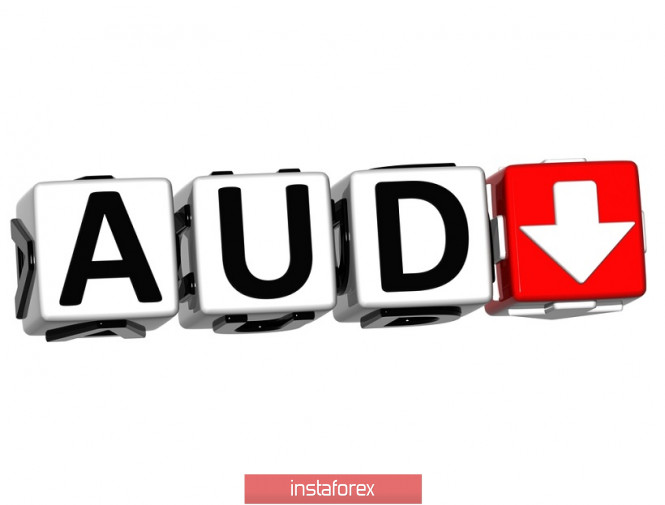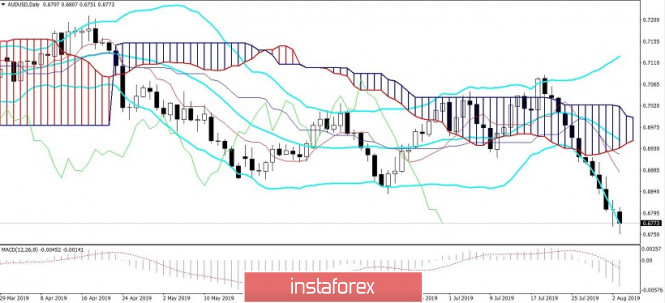Despite the general weakening of the US dollar, the AUD/USD pair the price tested a multi-year low of 0.675 in today's Asian session, which reflects the general pessimism of the pair. Although the downward impulse did not receive its continuation, the "Aussie" is under strong pressure from the fundamental background on the eve of the next meeting of the Reserve Bank of Australia, which will take place tomorrow.
The devaluation of the Australian dollar is due to several reasons. They can be divided into two parts, although they are certainly interrelated. The external fundamental background influences the dynamics of Australia's key macroeconomic indicators. First of all, we are talking about the escalation of the trade war between the United States and China. Recent events suggest that the parties will not come to a consensus in the foreseeable future and will not sign a historic deal. This means that the central banks of the leading countries of the world will remain in the path of easing the parameters of monetary policy, and the RBA in this context will not be an exception.

Let me remind you that the Australian regulator has already reduced the interest rate twice this year, but at the same time did not rule out another step in this direction until the end of the year. Global trade conflict increases the likelihood of a given scenario. During the last speech of the head of the RBA, Philip Lowe, focused his attention on three aspects, namely uncertainty about the growth of the global economy, weak inflation in Australia and the ambiguous situation in the labor market (weak growth in wages and high levels of part-time employment).
It is worth noting that inflation in the second quarter showed signs of recovery. According to the latest published data, the consumer price index rose to 1.6% (with a forecast of 1.5%) in annual terms and to 0.6% on a quarterly basis (with a forecast of 0.5% and the previous value of 0%). Although the published figures turned out to be slightly better than expected, the trend itself is important here - in particular, the figure rose in annual terms for the first time after a three-quarter decline.
However, such a "measured" growth dynamics did not satisfy the head of the Australian regulator. He stated that the Reserve Bank of Australia is ready for further policy easing in order to return inflation to its target range from 2% to 3%. Given this "announcement", traders of the pair should not expect tomorrow's "hawkish" notes. The overwhelming majority of experts do not expect any steps of the RBA at the August meeting but almost 100% sure about the September decline. I suppose tomorrow the members of the Central Bank will confirm these forecasts and announce an easing of monetary policy in the fall. If they limit themselves to just such a forecast, then the decrease in AUD/USD will be limited (a correctional pullback is also possible) since this scenario is already largely taken into account in prices.
Today's macroeconomic releases also exacerbated the already sad fundamental picture for the AUD/USD pair. Thus, the activity index in the service sector from AiG (Australia's PMI equivalent) collapsed again under the key 50-level mark and reached 43.9 points. From January to April, the indicator went below this target, then it went out at the level of 53 points for two months and now, it shows the deterioration of the situation again.
In addition, today another disappointing data from the Middle Kingdom was published, which again reminded the market of the slowdown of the world's largest economy. Thus, the index of business activity in the services sector from Markit (Markit Services PMI) fell sharply in July, reaching 51.6 points. Over the previous three months, this indicator went on within the framework of 52 points, which is why such a sharp and most importantly unexpected a downward jump compared to the forecast at the level of 52.5 points. This had an impact on the dynamics of today's trading. The Australian dollar is most sensitive to the decline in Chinese indicators since China is the main trading partner of the Green Continent.
Thus, the Aussie is under the yoke of a negative fundamental background. The escalation of the trade war, as well as almost 100% market confidence in reducing the interest rate of the RBA at the September meeting, put pressure on AUD/USD pair. Some experts now admit the option of reducing the rate to 0.5% by the spring of next year. If the Australian regulator doesn't rule out such a scenario tomorrow, Ozzy will go to the final knockdown.

Technically, the picture is fully consistent with the foundation. On the daily chart, the price is on the bottom line of the Bollinger Bands indicator (which in turn is in the extended channel) and under the Kumo cloud. In addition, the Ichimoku Kinko Hyo indicator has formed a "Parade of Lines" bearish signal, and the MACD oscillator shows a strong oversold condition. All of the above clearly indicates the priority of the southern long-term movement with a price target of 0.6620, which is the bottom line of the Bollinger Bands indicator on the monthly chart. In turn, the closest resistance level is at the of 0.6880 mark, which is where the stop can be located and the Tenkan-sen line on D1.
The material has been provided by InstaForex Company - www.instaforex.com